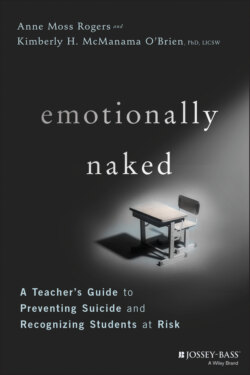Читать книгу Emotionally Naked - Anne Moss Rogers - Страница 23
The Impact of Increased Screen Time
ОглавлениеStudies have found that spending less than two hours per day of recreational screen time such as browsing the Internet playing games, watching videos, and using social media was associated with higher levels of life satisfaction and optimism, and lower levels of anxiety and depressive symptoms, especially among girls.13 While there is not enough definitive data specific to remote learning and its impact on student mental health, we do know that high levels of screen time do have an negative impact on a student's mental health.14
During the pandemic, calls to suicide hotlines went up 47% nationwide in June 2020 in the US, with some crisis lines experiencing a 300% increase.15 So it's not farfetched to assume that young people were not insulated from the emotional turmoil triggered by the pandemic, including parental job loss and income instability, and being stuck in a toxic home environment, along with the uncertainty and lack of connectedness of not attending school in person and seeing their peers. During online learning, spotting kids at risk and weeding them out for additional support or assessment became a challenge for educators as schools struggled to adapt quickly to a new digital delivery platform for teaching.
“The kids who were the highest risk were not on the Zoom sessions with their faces in class. Many of them tended to either miss class, sleep through class, or not have a picture in class. So it was very hard for us to find the high-risk kids, which is why our school counseling team sent out a survey. We send it out twice a semester and before the start of the year we were able to weed out the kids who were higher on the scale of showing that they were having more depressive and anxiety symptoms. The kids filled it out and there was a scale of how they were doing during COVID-19, how they were doing during remote learning, and we'd send it out a few times. It's always so important that the school counseling team, either guidance counselors, social workers, whomever is communicating with all the students, to be able to assess who is the most high risk. And honestly, as we know, the kids who are the most high risk are not calling us and saying, ‘Hey, I need some help.’ At our school, those kids tend to be on the sidelines, who we don't know. So if they're answering these surveys it's actually helpful, especially for the boys. Because again, boys are not calling their friends and saying, you know, ‘I'm feeling really sad today. Yeah, I'm feeling depressed, today.’”
Jessica Chock-Goldman, LCSW (She/Her/Hers), Doctoral Candidate, School Social Worker, Stuyvesant High School in Manhattan, New York
NOTE A copy of the survey mentioned can be found in Chapter 12, “Quizzes, Worksheets, Handouts, Guides, and Scripts.” Worksheet 3: Student Wellness Surveys features one for distance learning and one for in-classroom learning.
